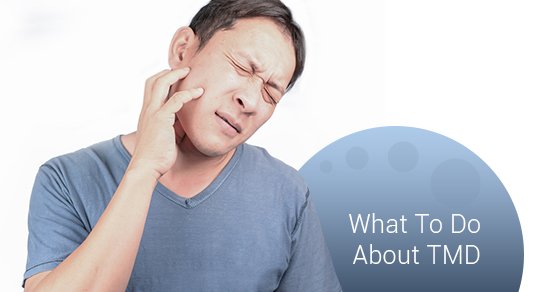TMD stands for temporomandibular joint disorder because it refers to afflictions of the temporomandibular joint (TMJ). These joints are found on either side of the head, in front of the ears and connect the jawbone to the skull. The joints can rotate, move backward, side-to-side and forward. It lets you chew, swallow, speak and yawn, but if a problem occurs with the bone, muscle or tissues in or around the TMJ, it could lead to TMD. For a deeper overview of symptoms, causes, and treatment options, you can learn more about TMD here.
If you suffer from TMD there are things you can do to help relieve the pain and pressure associated with it.
Medication
There are over-the-counter medications you can take to reduce the swelling of the TMJ. Try nonsteroidal anti-inflammatory drugs (NSAIDs) such as ibuprofen and naproxen.
Avoid pressure
Keep your jaw movements to a minimum by avoiding chewing gum and resting your chin on your hand. Chewing gum forces you to keep your mouth open wide for long periods of time and resting your chin on your hand creates pressure on the joints. If you are chewing gum after meals to prevent bad breath, try mouthwash instead. Also, practice good posture when sitting down so you don’t find yourself resting your chin on your hand.
Keep your teeth slightly apart
To relieve pressure on your jaw, put your tongue between your teeth. This will keep you from clenching or grinding your teeth during the day. If you are a night grinder, ask your dentist to fit you with a bite guard to wear while you sleep. If clenching or grinding (bruxism) is part of the issue, see our guide on TMJ disorder and bruxism.
Get enough sleep
This is often easier said than done, but the less yawning you do during the day, the less pressure you put on your TMJ. If you can get between six to eight hours of sleep per night this will keep you from yawning.
Eat soft foods
Chewing is going to be painful if you suffer from TMD so stick to soft foods like eggs, cooked fruits and vegetables, and yogurt. Avoid sugary and hard foods that require a lot chewing to break down. If you do need to eat harder foods like chicken or beef, make sure you cut them into small, easy-to-chew pieces.
See your dentist
If you’ve tried these home remedies and are still having issues with TMD, make a dentist appointment. Your dentist can help determine if other measures need to be taken. Also, your dentist can recommend jaw stretches or refer you to a physiotherapist.
For more information about TMD treatments or to make an appointment, contact us today.
